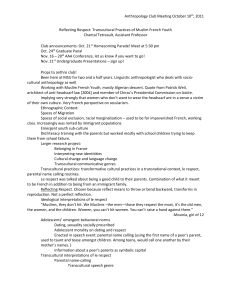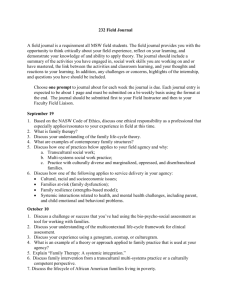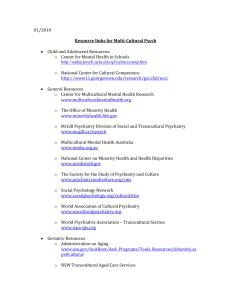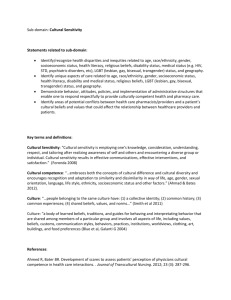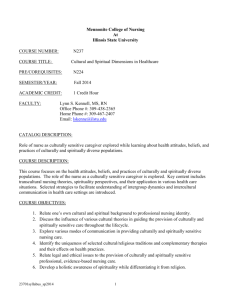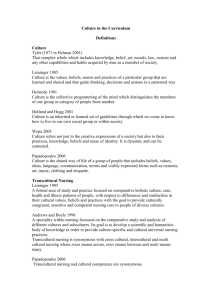Transcultural Communication Barriers Ethnocentrism
advertisement
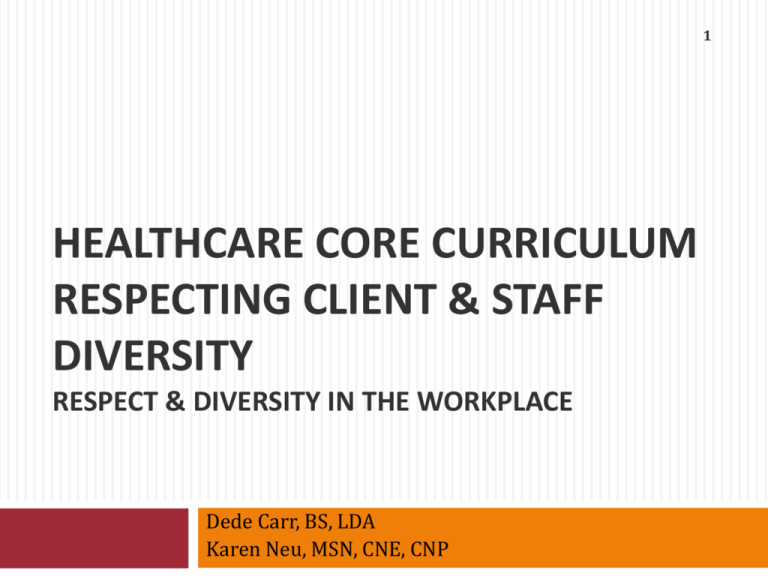
1 HEALTHCARE CORE CURRICULUM RESPECTING CLIENT & STAFF DIVERSITY RESPECT & DIVERSITY IN THE WORKPLACE Dede Carr, BS, LDA Karen Neu, MSN, CNE, CNP U.S. Department of Labor Grant 2 “This workforce solution was funded by a grant awarded by the U.S. Department of Labor’s Employment and Training Administration. The solution was created by the grantee and does not necessarily reflect the official position of the U.S. Department of Labor. The Department of Labor makes no guarantees, warranties, or assurances of any kind, express or implied, with respect to such information, including any information on linked sites and including but not limited to, accuracy of the information or its completeness, timeliness, usefulness, adequacy, continued availability, or ownership. This solution is copyrighted by the institution that created it. Internal use, by and organization and/or personal use by an individual or non-commercial purposes, is permissible. All other uses require the prior authorization of the copyright owner.” 3 Respect & Diversity in the Workplace Competencies 3 and 4: Explore personal responsibility as a healthcare employee to treat each person as an individual. Discuss the appropriate workplace expectations to interact with team members and care for clients/individuals form diverse cultures, genders, age groups and/or sexualities. Respect & Diversity in the Workplace 4 In this lesson we will explore the role of cultures and subcultures in the workplace, the healthcare workers responsibilities in providing transcultural (across cultures) care. The goal of transcultural care is culturally congruent care or care that fits the person’s valued life patterns and set of meanings. Patterns & meanings are generated from people themselves, rather than predetermined criteria. (Potter & Perry, p. 108) Respect & Diversity in the Workplace 5 Culturally congruent care is sometimes different from the values & meanings of the professional health care system. Example, the healthcare workers’ values & meanings may be different than the hospital’s, nursing home’s , and clinical office’s. It is important for healthcare workers to assume the role of learners and partner with clients & their families in defining characteristics of meaningful & beneficial care by discovering the clients’ cultural care values, meanings, beliefs, & practices as they relate to nursing & healthcare. (Potter & Perry, p. 108) Culturally Competent Care 6 Culturally competent care is the ability of a healthcare worker to bridge cultural gaps in caring, work with cultural differences, & enable clients and families to achieve meaningful & supportive caring. Cultural competence is the synthesis of three distinct levels: individual, organizational, and societal. Cultural competence is a process of development of five interlocking components: cultural awareness, knowledge, skill, encounters, & desire. (Potter & Perry, p. 108) Culturally Competent Care 7 Cultural awareness is an in-depth self-examination of one’s own background, recognizing biases & prejudices & assumptions about other people. Cultural knowledge is obtaining sufficient comparative knowledge of diverse groups, including their indigenous values, health beliefs, care practices, worldwide view, & bio-cultural ecology. Cultural skills include assessment of social, cultural, & biophysical factors influencing treatment and care of clients. (Potter & Perry, pp. 108-109) Culturally Competent Care 8 Cultural encounters involve the engagement in cross cultural interactions that provide learning of other cultures & opportunities for effective intercultural communication development. Cultural desire is the motivation and commitment to caring that moves an individual to learn from others, accept the role as learner, & be open and accepting of cultural differences, and build upon cultural similarities. Cultural competence is the process of acquiring specific knowledge, skills, & attitudes that ensure the delivery of culturally competent care. (Potter & Perry, pp. 108-109) Cultural Self-Awareness 9 Through the activities & from the power point lecture “Personal Belief System,” you explored the components, elements, and types of a belief system as well as the development of a belief system and completed a personal self-assessment of your personal beliefs and values. This was part of the first step in providing culturally competent care (cultural selfawareness). Cultural Knowledge 10 Culture and subcultures, the process of adjustment & adaptation to a dominant & new culture, and information about some specific cultural groups were explored in “Cultural Belief System.” “Cultural Belief System” provided you with an opportunity to increase your knowledge about some cultural groups which is the second step in becoming culturally competent. The remainder of developing your abilities of culturally competent care will continue even as you go into healthcare practice. 11 Health Care Core Curriculum Transcultural Communication Barriers Transcultural Communication Barriers 12 Misunderstandings between people and their cultures occur for many reasons. The barriers to transcultural communication that will be addressed in the next few slides are: Lack of Knowledge Fear, Dislike, & Distrust Racism Bias & Ethnocentrism Stereotyping Ritualistic Behavior Language Barriers Differences in Perceptions & Expectations 13 Transcultural Communication Barriers Lack of Knowledge Lack of Knowledge is the failure to understand cultural differences in values, behaviors, & communication styles, a common barrier for individuals working in transcultural settings. Unless a person is knowledgeable in many areas of transcultural communication, they risk misinterpreting a person’s attempt to communicate. As a result in the healthcare arena, this may cause a patient to receive less than proper care. (Juliar, p. 343-344) Transcultural Communication Barriers Lack of Knowledge 14 Lack of Knowledge An example of lack of knowledge: Japanese patients might react with silent obedience to your requests, white middle-class patients might wish to discuss their nursing care with you, Italian patients might dramatically express their discomfort, while an inner city youth might loudly demand your attention. Health care workers who have not learned about which behaviors are acceptable in different cultures may attribute a client’s behavior (i.e. silence, withdrawal) to the wrong reason or cause, which can result in the wrong assessment & interventions. (Juliar, p. 343-344) 15 Transcultural Communication Barriers Fear, Dislike, Distrust Emotional Barriers: Fear, Dislike, Distrust The emotions of dislike, fear, & distrust are common when people from differing cultures come together. There are seven stages of adjustment that individuals progress through during their initial encounters with different cultural people that they do not know or understand. Seven Stages of Adjustment 1. 2. 3. 4. Fear Dislike Distrust Acceptance 5. Respect 6. Trust 7. Like Transcultural Communication Barriers 16 Stages of Adjustment #1-Fear is a common barrier to communication. When first meeting a culturally different person, many feel threatened, perceive the other as different & dangerous. Getting to know a person, & his/her culture will often times dissipate the fear & turn it into dislike. #2-Dislike is a milder emotion. Members of groups tend to dislike people who behave or communicate differently from what they consider the “norm” of the culture or group. Transcultural Communication Barriers 17 Stages of Adjustment #3-Distrust is another barrier to transcultural communication. Distrust develops because people from different cultural backgrounds are often apprehensive of each other’s actions & motives. “For example, a white nurse who does not realize the importance of family in Vietnam, may be suspicious of the new Vietnamese nurse who allows family members to participate in a patient’s care instead of providing all of the care herself.” Unless there is pressure to change attitudes, some people never progress beyond fear, dislike, & distrust to the next stage of acceptance. (Juliar, p. 345) Transcultural Communication Barriers 18 Stages of Adjustment #4-Acceptance of each other rather than resentment of each other occurs if two different cultural people share enough good experiences over a period of time. Transcultural Communication Barriers 19 Stages of Adjustment #5-Respect: If individuals from diverse cultures are open-minded, they will allow themselves to see & admire each other’s qualities. For example, a Japanese physical therapist who had been trained to defer to authority might admire the white American physical therapist who challenges authority. Respect is fostered through acceptance & admiration. (Juliar, p. 345) Transcultural Communication Barriers 20 Stages of Adjustment #6-Trust: Once diverse cultural people spend quality time together, they usually begin to trust each other. For example, a white American medical assistant will eventually trust the foreign-born nursing assistant who consistently provides good client care & finishes assignments on time. Once people trust, they genuinely learn to like each other. #7-Like: Many things must be shared for people to like each other. In order to reach this stage, diverse cultural individuals must be able to focus on the human qualities that bind people together rather than differences which separate people. (Juliar, p. 346) 21 Transcultural Communication Barriers Racism Racism in the American health care delivery system is a transcultural communication barrier. Three types of racism: (Barbee, as cited in Juliar, p. 346) Individual racism-discrimination of individuals because of their visible biological characteristics, such as skin color or eyelid folds, Cultural racism-Individuals or institutions claim their heritage is superior to other individuals or institutions (WWII Nazi’s claim of superiority to the Jewish heritage so they were justified in persecuting the Jewish people) Institutional racism-(universities, businesses, hospitals, medical offices) manipulate or tolerate policies that unfairly restrict opportunities of certain races, groups, or cultures. (At one time black nurses were not allowed to join the American Nurses’ Association (ANA) preventing them from having a voice in the regulation of nursing practice & policies.) (Juliar, pp. 346-347) 22 Transcultural Communication Barriers Biases & Ethnocentrism Over all, people have a tendency to be biased towards their own culture & it’s values. People feel that their values are right while the values within other cultures are wrong or not as good. It is then surprising to many people when they discover that what they value within their own culture is often looked upon with skepticism or suspicion from individuals within another culture. Funny how these folks from another culture are then equally biased. (Juliar, p. 347) 23 Transcultural Communication Barriers Ethnocentrism Ethnocentrism is the belief that one’s own culture or way of life is better than that of others. (Berman et al., p. 315) Simultaneous dual ethnocentrism is a component of every health care professional-client relationship. Healthcare professional are assessing, judging, evaluating, & reacting to clients on the basis of their own cultural values, medico-centric points of view, & expectations. Simultaneously, clients are using their cultural values to judge & evaluate healthcare professional & the Western healthcare system. (Juliar, p. 348) 24 Transcultural Communication Barriers Simultaneous Dual Ethnocentrism “The concept of simultaneous dual ethnocentrism makes healthcare professionals keenly aware that they, their patients, their colleagues, and everyone else in the clinical setting are operating under the influence of personal cultural rules, some of which are shared & some of which are not.” (Juliar, p. 348) Transcultural Communication Barriers Ethnocentrism 25 Attitudes towards Western medicine are one of the biggest barriers between clients & healthcare workers. Since most healthcare professionals have been educated in Western medicine, many believe the biomedical health belief system is the best approach (even the only approach) to client care & treatments. Healthcare professionals view other health belief systems with suspicion or contempt & refuse to acknowledge that another system might have some merit. This ethnocentric attitude can alienate clients from other cultures who fully believe their therapeutic interventions have merit. (Juliar, p. 348) Transcultural Communication Barriers Biases, Ethnocentrism, Prejudices 26 Ethnocentrism is the cause of biases & prejudices that associate with negative permanent characteristics with people who are different from the valued group. When a person acts on these prejudices, discrimination occurs. (Potter & Perry, p. 109) “Discrimination, the differential treatment of individuals or groups based on categories, such as race, ethnicity, gender, social class, or exceptionality, occurs when a person acts on prejudice & denies other persons one or more of their fundamental rights.” (Berman et al., p. 315) Transcultural Communication Barriers Prejudice 27 Prejudice is a negative belief or preference that is generalized about a group & leads to “prejudgment.” Prejudice occurs because either the person making the judgment does not understand the particular person or his/her heritage, or the person making the judgment generalizes an experience with one individual from a culture to all members of that group. It may also be referred to as racism. A related concept is xenophobia—the fear or dislike of people different from one’s self. (Berman et al., p. 315) 28 Transcultural Communication Barriers Stereotyping Stereotyping is assuming that all members of a culture or ethnic group are alike. Stereotyping may be based on generalizations founded in research, or it may be unrelated to reality. For example, a nurse may assume that all Italians verbally express pain loudly or that all Chinese people like rice. For example, research indicates that most Italians are likely to express pain verbally; however a specific Italian client may not do so. Stereotyping that is unrelated to reality is frequently an outcome of racism or discrimination. (Berman et al., p. 315) 29 Transcultural Communication Barriers Cultural Stereotype The ancients first formed cultural stereotype when they came upon a new race or tribe. They quickly had to decide if the people were safe to encounter. Since there wasn’t much time to figure if the group was safe or not, judgments where made towards the race or tribe as a whole, and not on an individual basis. These assumptions, or stereotypes, were then passed down from generation to generation & still impact our lives today. Books & films have supported the aspect of cultural stereotype. For example, they depict the black man who is a great basketball player or the black woman who is a servant for a white woman. (Eagle Feather Research Institute) 30 Transcultural Communication Barriers Assumptions of Stereotyping All people within a culture believe in the same values All people within a culture (racial & ethnic group) are alike. Ex. All Eskimos are reserved, deliberate & noncommittal. Some or maybe even the majority may be reserved, deliberate, & noncommittal, but it is a cultural stereotype to state that all Eskimos have these traits. (Juliar, pp. 349-350) All people within a culture look, talk, and act alike. Stereotyping is particularly destructive when negative traits or characteristics are imposed on all members of the cultural group. Ex. All Native Americans are at risk for alcoholism. (Juliar, p. 350) When assumptions & stereotypes influence our attitudes, we may find that making a fair judgment about someone or something is difficult. This influence on judgment is called a "bias.” (Juliar) 31 Transcultural Communication Barriers Assumptions about Stereotyping There are many stereotypes about Americans. Americans tend to be loud & boisterous is one stereotype. If you have ever been to a Vikings game, think of how loud the stadium can get. How about when visiting a nice restaurant? It, too, can be quite loud. Many people that you meet outside of the American culture will tend to be quiet & polite. Americans tend to be quite informal in their dress and yet whenever there is a religious event to attend, i.e. a wedding or funeral, they know how to dress up. (Kantrowitz) 32 Transcultural Communication Barriers Assumptions about Stereotyping Other stereotypes, or assumptions, that people have about Americans are that Americans are: Boastful and arrogant. Insensitive. Racist. Disrespectful of Authority Insensitive Rich and wealthy Drunkard Lazy Rude and immature Think they know everything. Uninformed about politics Snobbish Thinks every country should imitate the US Extravagant and wasteful Stingy (Kantrowitz) Transcultural Communication Barriers Cultural Blind Spot Syndrome 33 Cultural blind spot syndrome is a belief that “just because the client looks & behaves much the way you do, you assume that there are no cultural differences or potential barriers to care.” (Buchwald, as cited in Juliar, p. 350) For example, white American nurses may assume that white American patients believe in the same cultural values as they do. This assumption is false. White Americans come from many different ethnocultural backgrounds—Irish, Russian, German, Jewish, & English to name but a few. In addition, white nurses & patients may also belong to different subcultures that have different values. For example, a white male patient of Italian descent who is gay will probably have somewhat different values than a white IrishAmerican nurse who is married with 3 children. (Juliar, p. 350) 34 Transcultural Communication Barriers Ritualistic Behavior Ritual is a set procedure for performing a task. There are many healthcare rituals, such as performing safety checks when preparing & administering medications. However some rituals, such as always excluding extended family from the bedside during treatments are unnecessary & may upset the clients & their families. Unfortunately, some healthcare workers become deeply irritated & disturbed when these rituals are challenged. (Juliar, p. 351) 35 Transcultural Communication Barriers Language Barriers Language Barriers Because language is the tool to used to communicate with one another, language barriers present many obstacles to transcultural communication. These barriers include: Foreign languages Different dialects “Street talk” and idioms (Juliar, p. 351) 36 Transcultural Communication Barriers Foreign Languages and Dialects Foreign Languages and Dialects Some facts: Over 6,000 different languages & dialects are spoken today The number of people in America who speak a language other than English is growing 10% of the population speak more than just English To communicate effectively with clients you may need an interpreter (Juliar, p. 351) Transcultural Communication Barriers Definitions of Dialect 37 Definitions of Dialect “A distinctive way a language is spoken or written in a given locality or by a group of individuals.” (Webster’s Dictionary as cited in Juliar, p. 352) “A regional or social variety of a language distinguished by pronunciation, grammar, or vocabulary, especially a variety of speech differing from the standard literary language or speech pattern of the culture in which it exists.” (Dictionary .com) “The language peculiar to the members of a group, especially in an occupation; jargon” (thefreedictionary.com) Regionalism is a word, phrase, pronunciation, or custom peculiar to a given region; example-three major Chinese dialects: Mandarin, Cantonese, & Slanghainese (Juliar, p. 352) Transcultural Communication Barriers Street Talk, Slang, & Idioms 38 Street Talk, Slang, Idioms & Medical Terminology Street talk, slang, & idioms are expressions that are used by people that can sometimes create a language barrier. For example, if you are from a white middle class family, you may not understand that when an African-American person uses the word “hood” they are referring to their neighborhood or that the “Amen Corner” refers to the corner in the church where the older women of the church sit. (Juliar, p. 353) Language barriers may occur when clients & healthcare workers use different terminology when discussing health & illness. (Juliar, p. 362) 39 Transcultural Communication Barriers Gender-Communication Issues There are more males entering the previously predominant female occupation of nursing and healthcare. This brings another subculture & the possibilities for stereotyping, biases, and prejudices. Even though women and men are more similar than different, some communication patterns are identifiable. The key to working effectively with the opposite gender is to recognize communication differences & then realize enormous contributions each style brings to the workplace. While men can be more direct and get right to the point, women often bring valuable interpersonal skills to the workplace. Both men & women are effective problemsolvers. Men usually think of one thing at a time & women tend to consider several things at once. (Juliar, p. 390) 40 Transcultural Communication Barriers Conflicting Perceptions & Expectations When people from different cultures try to communicate, their best efforts may be thwarted by misunderstandings or even serious conflicts. This happens in healthcare when people have different perceptions or expectations & consequently misinterpret each other’s messages. When there are cultural, behavioral, & language differences between healthcare workers, client’s & their families, there is greater probability that clients will misunderstand care instructions. To prevent conflicts & misunderstandings, make sure that the message you send the client is the same message that the client receives. When there is a language barrier, you will need to work closely with an interpreter. (Juliar, pp. 354-355) 41 Transcultural Communication Barriers Perceptions & Expectations Conflict Example: Cultural differences frequently occur around food & drink. For example, a post surgery Vietnamese client is constantly attended by her family as culture dictates. You want the family not to give her any food or drink. As the family only speaks Vietnamese, you motion that the client should not drink & you explain via an interpreter that the client should not drink. When you return from a lunch break you find your client vomiting and you observe a bowl of soup on her table. Obviously the family ignored your instructions & fed the client soup. If you angrily say, I told you not to give her anything to drink!” your reaction would be that of many health care workers. Later you learn from the interpreter that the family knew they should not give the client water, but they assumed that broth would be beneficial as they believe the sick need to drink broth for energy. Your intended message (do not drink anything) was not understood by the client’s family, & you failed to grasp the family’s perception of your instructions (broth is not water and therefore all right to drink). As a result, the client’s family gave her broth and you became frustrated. (Juliar, p. 354) Transcultural Communication Barriers Perceptions & Expectations 42 Conflict-Perceptions about health promotion & disease prevention Example: Hispanics [culture based on honor & pride-may be taught from childhood to bravely accept illness & pain as an inevitable part of human existence] Traditional Hispanics may see no reason for mammograms or vaccinations (fatalist beliefs). “We’ve been taught that you live, you suffer, you die. That’s the way life is. The idea has never been presented to take care of your health, if you go to the doctor early you won’t have to suffer pain or discomfort.” (Juliar, p. 355) Cultural Prejudice 43 As you have learned, interactions with people from a cultural other than your own have many different layers to it. Cultural prejudice is not uncommon & yet because the country we live in is such a large melting pot, it is critical to be culturally aware & sensitive to those around us & to those people we care for in the healthcare field. Cultural Prejudices 44 As we strive to treat each person as an individual, it is important to be aware of our own cultural prejudices. These cultural prejudices can take on a life of their own which can in turn be damaging to many of the people around us. 45 Health Care Core Curriculum Overcoming Transcultural Communication Barriers 46 Overcoming Transcultural Communication Barriers Now that you learned about the stumbling blocks to transcultural communication: Lack of knowledge; Fear, dislike, & distrust Racism Bias & ethnocentrism Stereotyping; Ritualistic behavior Language barriers Differences in perceptions & expectations What can YOU do as a healthcare worker to overcome these transcultural barriers? Overcoming Knowledge Deficits 47 Overcoming knowledge deficits: There are several ways healthcare workers can learn more about specific cultures: Attend classes & seminars that provide valuable information about transcultural communication. Many textbooks that describe the history, beliefs, & practices of major American cultural groups. Read novels, short stories, biographies, autobiographies, essays, & poems written by members of the cultural group. Documentaries, films, & TV programs that portray different cultures, foreign films, & films written, produced & directed by these groups (Juliar, pp. 358-359) Controlling Bias, Ethnocentrism, & Stereotyping 48 It’s impossible to completely overcome personal biases when caring for clients from different cultures, but becoming aware (bringing biases to one’s consciousness) & then controlling these biases when working with clients is the best approach (Charonko, 1992, as cited in Juliar, p. 359) Acknowledge client’s traditional healthcare beliefs & permit the client to follow those beliefs, provided they do not interfere with the client’s medication & treatment program To acknowledge that clients have the right to their own healthcare beliefs is a major step toward overcoming personal & professional biases & ethnocentrism. (Juliar, p. 360) Overcome Terminology Differences 49 To overcome terminology differences listen to terms that the client uses & use those terms when caring for the client. Avoid using abbreviations, such as TPR or MI without explaining what they mean to the client. Clients who have difficulty with English may be particularly confused by medical terms. To provide optimal care take the time to explain medical terminology, directions, & procedures to your clients in terms they understand. Encourage clients to ask questions & express feelings & concerns. (Juliar, pp. 362-365) 50 Overcome Barriers to Transcultural Communication To reduce incompatibilities in transcultural communication: Strive to understand the client’s perceptions & expectations of you & the biomedical system Take the time to elicit information about the client’s healthcare belief system In simple terms, carefully explain your role in the assessment process & why it is vital that the client answer your questions (Juliar, p. 368) Overcome Barriers to Transcultural Communication 51 To reduce incompatibilities in transcultural communication: Welcome questions from your client & answer them as clearly & simply as possible Allow the client’s traditional healing practices provided that they do not interfere with the prescribed treatment regimen If the client’s health care practices do conflict with the biomedical practices, communicate with your client until you develop a plan of care that is acceptable to you, the client, & the physician (Juliar, p. 368) Tips for Cross Gender Communication 52 When men & women recognize & appreciate the strengths of both genders bring to the workplace, an increase is seen in creativity, productivity, & profit. Recognize that gender difference in communication exist and try to understand their merits. Your success at work will come not from abandoning your communication style and adopting that of the other gender, but rather from recognizing, appreciating, and utilizing everyone’s strengths. (Juliar, pp. 390-391) To communicate more effectively see the following slides. Cross-Gender Communication Tips for Men 53 Seek input & ask questions to confirm understanding & agreement. Avoid interrupting & monopolizing the floor. Be aware that your comments may be taken personally. Tone down criticisms & sarcasm; focus on being more polite; ask, don’t order. Never refer to a co-worker as “sweetheart,” “dear,” or some similar name. Realize the rapport building is just as important as getting results. Avoid gender-based language. For example say “salesperson” rather than “salesman” or “workers” instead of “workmen.” Encourage others to communicate & value their input. (Juliar, 390) Cross-Gender Communication Tips for Women 54 Don’t give in to interruptions. Say, “I’m sorry, but I’m not finished yet.” Make a conscious effort to take comment less personally. Avoid putting questions like “don’t you think?” and “is that okay?” at the end of your comments. They make you sound unsure. Strive to be more direct with comments and criticism. Get to the point quickly. Avoid inappropriate nonverbal signals, such as nodding too often, or avoiding direct eye contact. They decrease your credibility. Don’t expect that others will open up to you about personal things; avoid discussing anything personal. Realize that getting thing done is just as important as relationship building. Encourage others to communicate and value their input. (Juliar, 390) References 55 Berman, A., Snyder, S.J., Kozier, B., & Erb, G. (2008).Culture and heritage. In A. Berman, S.J. Snyder, B. Kozier, & G. Erb (Eds.). Kozier & Erb’s Fundamentals of nursing: Concepts, process, and practice (8th ed.) (pp. 311-329). Upper Saddle River, NJ: Prentice Hall Buchwald, D. et al. (1994). Caring for patients in a multicultural society. Patient care 28(11):105–123. Eagle Feather Research Institute. (2008). Ancient Cultural Stereotypes. Retrieved from http://eaglefeather.org/articles/why_ancient_cultural_stereotypes_formed. php Juliar, K. (2003). Transcultural communications stumbling blocks. Retrieved from http://webtools.delmarlearning.com/sample_chapters/0766802566_04.pdf Kantrowitz, M. (2011). Stereotypes. Retrieved from http://www.edupass.org/culture/stereotypes.phtml
